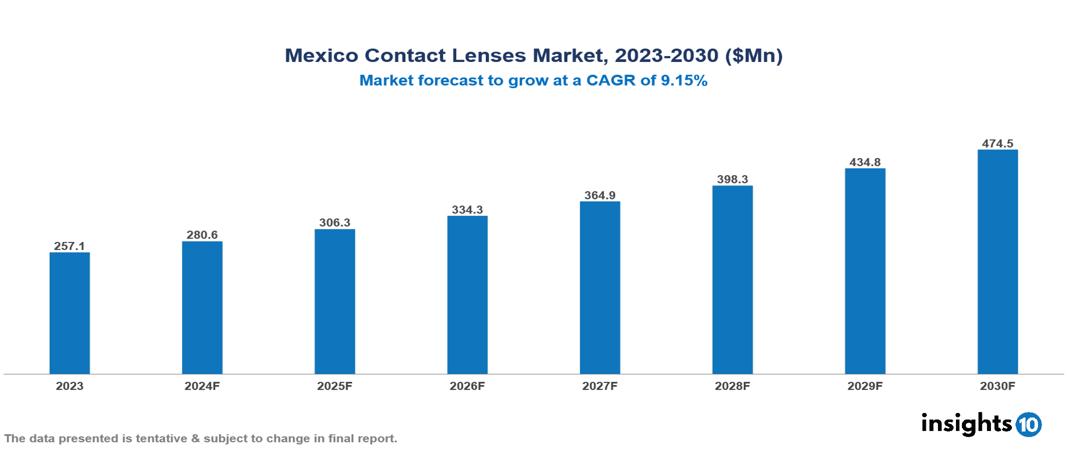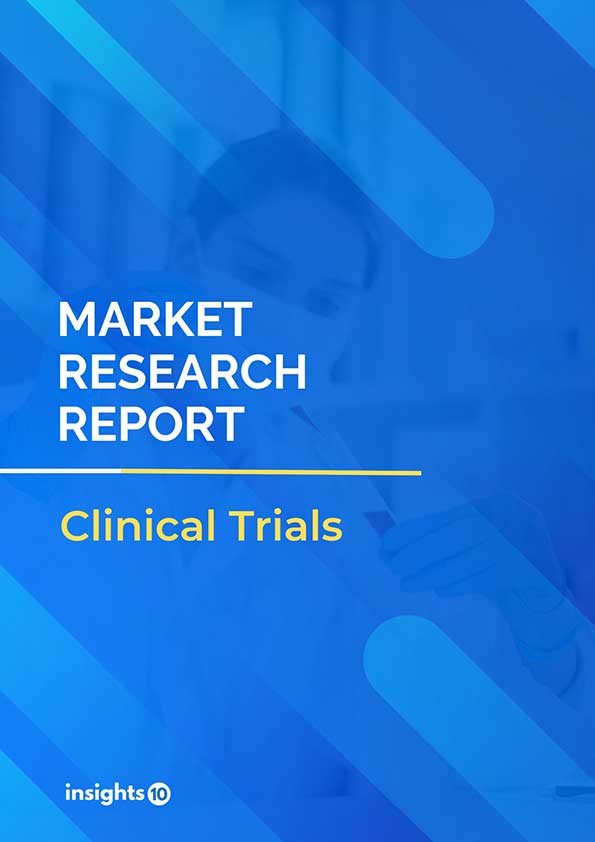Mexico Contact Lenses Market Analysis
Mexico Contact Lenses Market was valued at $257.10 Mn in 2023 and is predicted to grow at a CAGR of 9.15% from 2023 to 2030, to $474.54 Mn by 2030. The key drivers of this industry include rising disposable income, a high prevalence of eye disorders, and a growing focus on aesthetics. The industry is primarily dominated by Bausch and Lomb, CooperVision, Alcon Vision, and Essilor among others.
Buy Now

Mexico Contact Lenses Market Executive Summary
Mexico Contact Lenses Market was valued at $257.10 Mn in 2023 and is predicted to grow at a CAGR of 9.15% from 2023 to 2030, to $474.54 Mn by 2030.
Contact lenses are versatile medical devices placed directly on the eye, serving both functional and cosmetic purposes. They come in several types: soft lenses, made of flexible plastic allowing oxygen to the cornea; rigid gas permeable lenses for sharper vision; hybrid lenses combining features of both; and scleral lenses covering the cornea and sclera, useful for irregular corneas. They correct refractive errors like myopia and hyperopia and cater to cosmetic needs with colored variants. Fitting by an optometrist or ophthalmologist ensures proper selection based on individual eye health and lifestyle. Regular cleaning and adherence to wearing schedules are crucial for preventing infections and maintaining eye health. Risks include infections, dry eyes, and corneal abrasions if not used correctly. Regulated as medical devices, advancements like silicone hydrogel materials and UV-blocking capabilities enhance safety and comfort, making contact lenses a popular choice for vision correction and aesthetic enhancement globally.
In 2020, cataracts led to blindness in approximately 15.2 Mn people aged 50 and older worldwide, with an additional 78.8 Mn suffering from moderate and severe vision impairment (MSVI) due to cataracts. Since 2000, cataract blindness cases have increased by 29.7%, and MSVI cases by 93.1%. Mexico, part of Latin America, also grapples with significant eye health challenges, including a heightened risk of developing cataracts, diabetic retinopathy, glaucoma, and macular degeneration among individuals aged 40 and older.
The market therefore is driven by significant factors like rising disposable income, high prevalence of eye disorders, and growing focus on aesthetics. However, limited public insurance coverage, lack of awareness regarding proper care, and competition from refractive surgery restrict the growth and potential of the market.
Prominent players in this field are Bausch and Lomb, which emphasizes daily disposable contact lenses enhanced with comfort technologies and supports sustainability initiatives. On the other hand, CooperVision focuses on innovation through advanced materials, specialized solutions for myopia management, and convenient subscription services for contact lenses. Other contributors include Alcon Vision LLC, and Essilor International S.A. among others.

Market Dynamics
Market Growth Drivers
Rising Disposable Income: Mexico's economy is on an upward trajectory, leading to increasing disposable income for many Mexicans. The World Bank estimates Mexico's GDP per capita at $19,140 in 2023. This allows people to spend more on discretionary items like contact lenses.
High Prevalence of Eye Disorders: Statistics suggest a significant portion of the Mexican population suffers from vision problems. Mexican ophthalmic device market, which includes contact lenses, is expected to reach $1.4 Bn by 2027. This growth is partly driven by the prevalence of eye conditions.
Growing Focus on Aesthetics: There's a growing trend in Mexico, particularly among younger demographics, of prioritizing aesthetics. Coloured contact lenses offer a way to enhance appearance, driving demand in this segment of the market.
Market Restraints
Limited Public Insurance Coverage: Contact lenses are generally not covered by Mexico's public health insurance system. This can be a barrier for some consumers, particularly those with limited financial resources.
Lack of Awareness Regarding Proper Care: There is a lack of awareness about the correct hygiene and care practices for contact lenses. This shortfall can result in complications and shorter wear duration, which may deter potential users.
Competition from Refractive Surgery: Advancements in laser vision correction procedures like LASIK are becoming increasingly accessible in Mexico. While not suitable for everyone, these options present some competition for the contact lens market for specific demographics.
Regulatory Landscape and Reimbursement Scenario
In Mexico, the regulatory oversight of contact lenses is managed by COFEPRIS (Comisión Federal para la Protección contra Riesgos Sanitarios). All contact lenses, including corrective and cosmetic varieties, must be registered with COFEPRIS before being imported, distributed, or sold. This process requires submitting technical documentation and demonstrating compliance with Mexican safety and performance standards. Contact lenses are classified based on risk, with most falling under Class II (medium-risk), necessitating detailed registration. Specialty lenses, categorized as Class III (high-risk), have stricter registration requirements. Manufacturers and distributors must implement a Quality Management System (QMS) adhering to international standards like ISO 13485 to ensure product quality and safety. Additionally, post-market surveillance is mandatory to monitor product performance and report any adverse events to COFEPRIS.
Regarding reimbursement, contact lenses are generally not covered by Mexico's public health insurance system. However, there are exceptions for medically necessary lenses prescribed by an ophthalmologist for specific eye conditions, which might receive partial coverage depending on the individual’s health insurance plan. Some private health insurance plans in Mexico may offer partial or full coverage for contact lenses, with the extent of coverage and eligibility criteria varying significantly based on the specific plan details.
Competitive Landscape
Key Players
Here are some of the major key players in the Mexico Contact Lenses Market
- Abbott Medical Optics, Inc.
- Alcon Vision LLC
- Bausch & Lomb, Incorporated
- ZEISS International
- Contamac
- CooperVision, Inc.
- Essilor International S.A.
- Hoya Corporation
- Medennium
- Seed Co., Ltd.
1. Executive Summary
1.1 Device Overview
1.2 Global Scenario
1.3 Country Overview
1.4 Healthcare Scenario in Country
1.5 Regulatory Landscape for Medical Device
1.6 Health Insurance Coverage in Country
1.7 Type of Medical Device
1.8 Recent Developments in the Country
2. Market Size and Forecasting
2.1 Market Size (With Excel and Methodology)
2.2 Market Segmentation (Check all Segments in Segmentation Section)
3. Market Dynamics
3.1 Market Drivers
3.2 Market Restraints
4. Competitive Landscape
4.1 Major Market Share
4.2 Key Company Profile (Check all Companies in the Summary Section)
4.2.1 Company
4.2.1.1 Overview
4.2.1.2 Product Applications and Services
4.2.1.3 Recent Developments
4.2.1.4 Partnerships Ecosystem
4.2.1.5 Financials (Based on Availability)
5. Reimbursement Scenario
5.1 Reimbursement Regulation
5.2 Reimbursement Process for Diagnosis
5.3 Reimbursement Process for Treatment
6. Methodology and Scope
Mexico Contact Lenses Market Segmentation
By Material
- Gas Permeable
- Silicone Hydrogel
- Hybrid
By Design
- Spherical Lens
- Toric Lens
- Multifocal Lens
- Others Lens
By Application
- Corrective
- Therapeutic
- Cosmetic
- Prosthetic
- Lifestyle-oriented
By Distribution Channel
- E-commerce
- Eye Care Professionals
- Retail
By Usage
- Daily Disposable
- Disposable
- Frequently Disposable
- Traditional (Reusable) Lenses
Methodology for Database Creation
Our database offers a comprehensive list of healthcare centers, meticulously curated to provide detailed information on a wide range of specialties and services. It includes top-tier hospitals, clinics, and diagnostic facilities across 30 countries and 24 specialties, ensuring users can find the healthcare services they need.
Additionally, we provide a comprehensive list of Key Opinion Leaders (KOLs) based on your requirements. Our curated list captures various crucial aspects of the KOLs, offering more than just general information. Whether you're looking to boost brand awareness, drive engagement, or launch a new product, our extensive list of KOLs ensures you have the right experts by your side. Covering 30 countries and 36 specialties, our database guarantees access to the best KOLs in the healthcare industry, supporting strategic decisions and enhancing your initiatives.
How Do We Get It?
Our database is created and maintained through a combination of secondary and primary research methodologies.
1. Secondary Research
With many years of experience in the healthcare field, we have our own rich proprietary data from various past projects. This historical data serves as the foundation for our database. Our continuous process of gathering data involves:
- Analyzing historical proprietary data collected from multiple projects.
- Regularly updating our existing data sets with new findings and trends.
- Ensuring data consistency and accuracy through rigorous validation processes.
With extensive experience in the field, we have developed a proprietary GenAI-based technology that is uniquely tailored to our organization. This advanced technology enables us to scan a wide array of relevant information sources across the internet. Our data-gathering process includes:
- Searching through academic conferences, published research, citations, and social media platforms
- Collecting and compiling diverse data to build a comprehensive and detailed database
- Continuously updating our database with new information to ensure its relevance and accuracy
2. Primary Research
To complement and validate our secondary data, we engage in primary research through local tie-ups and partnerships. This process involves:
- Collaborating with local healthcare providers, hospitals, and clinics to gather real-time data.
- Conducting surveys, interviews, and field studies to collect fresh data directly from the source.
- Continuously refreshing our database to ensure that the information remains current and reliable.
- Validating secondary data through cross-referencing with primary data to ensure accuracy and relevance.
Combining Secondary and Primary Research
By integrating both secondary and primary research methodologies, we ensure that our database is comprehensive, accurate, and up-to-date. The combined process involves:
- Merging historical data from secondary research with real-time data from primary research.
- Conducting thorough data validation and cleansing to remove inconsistencies and errors.
- Organizing data into a structured format that is easily accessible and usable for various applications.
- Continuously monitoring and updating the database to reflect the latest developments and trends in the healthcare field.
Through this meticulous process, we create a final database tailored to each region and domain within the healthcare industry. This approach ensures that our clients receive reliable and relevant data, empowering them to make informed decisions and drive innovation in their respective fields.
To request a free sample copy of this report, please complete the form below.
We value your inquiry and offer free customization with every report to fulfil your exact research needs.









































